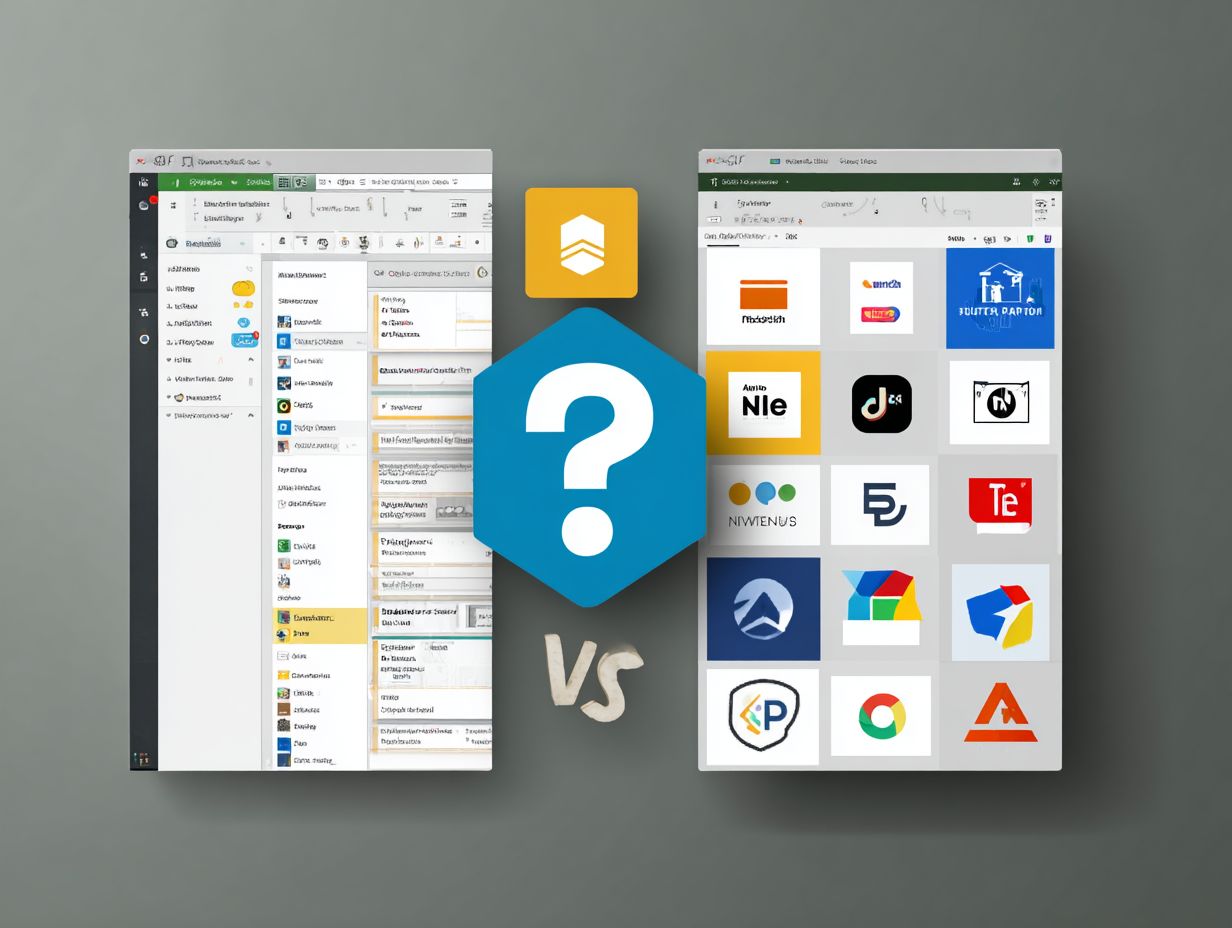Choosing Integration Tools: Built-in vs. Third-Party for CRM Systems
In our current focus on data, using CRM systems effectively is important for using customer information. As businesses look for better customer information, deciding between internal and external integration tools becomes important.
This article will examine the advantages and disadvantages of each choice, focusing on how combining data and the use of APIs impact marketing automation. By learning about these differences, you’ll be able to choose the right tools for your CRM system.
Key Takeaways:
- Built-in integration tools offer convenience and ease of use, but may have limited functionality and lack customization options.
- Third-party integration tools provide a wider range of features and flexibility, but may come with a higher cost and compatibility issues.
- When choosing integration tools for CRM systems, consider factors such as cost, scalability, and success stories to make an informed decision.
- Built-in Integration Tools Explained
- Exploring Third-Party Integration Tools
- Factors to Consider When Choosing Tools
- Case Studies and Examples
- Frequently Asked Questions
- 1. What are some integration tools available for CRM systems?
- 2. What are the advantages of using built-in integration tools for CRM systems?
- 3. What are the benefits of using third-party integration tools for CRM systems?
- 4. How do I decide between using built-in or third-party integration tools for my CRM system?
- 5. Can I use a combination of both built-in and third-party integration tools for my CRM system?
- 6. Are there any potential drawbacks to using third-party integration tools for CRM systems?
1. Importance of Integration in CRM

Connecting CRM systems helps see all customer interactions together, allowing decisions based on data, which can increase customer satisfaction by 25%.
For example, using tools like Salesforce or HubSpot helps businesses keep track of customer interactions through email, social media, and calls. This integration saves time and improves the customer experience.
Using analytics tools to track engagement can pinpoint problems, allowing for quick solutions. For a comprehensive understanding of how technology revolutionizes customer interactions, explore our insights on Customer Experience And Technology.
A case study showed that a retail company improved its response time by 30% after integrating its CRM with a helpdesk solution, demonstrating how effective integration can drive significant improvements in customer service.
2. Overview of Built-in vs. Third-Party Tools
Choosing between built-in CRM integration tools and third-party applications can significantly affect the effectiveness of your customer data management strategy.
Built-in CRM tools often provide seamless integration with existing systems, enhancing user experience without additional setup. They usually have important functions specific to their system, like creating reports automatically or monitoring customer support.
In contrast, third-party applications can offer specialized functionalities, with flexibility for customization. Tools like Zapier connect different platforms, letting you set up automatic tasks between your CRM and other software. Analyzing your team’s needs will clarify which option aligns best with your operational goals and budget.
Built-in Integration Tools Explained
Built-in tools make it easy to link different parts of a CRM system, enhancing workflow and simplifying the initial setup.
1. Advantages of Built-in Tools
Built-in CRM tools, such as HubSpot and Salesforce, provide tight integrations that reduce data silos and improve employee productivity by an estimated 20%.
For instance, HubSpot seamlessly connects with over 500 applications allowing teams to synchronize their marketing, sales, and customer service data. This means CRM activities can flow directly into your email marketing or social media tools, facilitating unified campaigns.
Salesforce provides dashboards and reporting tools that you can change to fit your requirements. This allows you to access real-time data analysis needed to make data-driven decisions. Using these tools often leads to faster sales processes and better lead management, so businesses should consider their needs carefully before selecting a platform.
2. Limitations of Built-in Tools
Despite their advantages, built-in tools can present limitations such as higher costs for advanced features and potential compatibility issues with legacy systems.
For example, many built-in project management tools charge extra for integrations with popular apps like Slack or Trello, whereas third-party alternatives often bundle these features.
Tools like Zapier or Integromat offer flexible automation without the high fees. Standard systems often lack options for customization, but Microsoft PowerApps allows you to make solutions that fit your requirements.
Look at what you need: if you often need updates and connections, using other tools could greatly improve how you work.
Exploring Third-Party Integration Tools

Third-party integration tools, such as Zapier and Nutshell, can improve CRM features by linking separate systems to create a clearer view of customer data. As mentioned in the Ultimate Guide To Customer Feedback Strategy, enhancing customer insights through integrated tools can significantly boost strategic decision-making.
1. Benefits of Third-Party Solutions
Utilizing third-party solutions can lead to increased flexibility and the ability to tailor customer experiences, significantly improving personalization efforts.
For instance, integrating CRM tools like Salesforce enables better customer data analysis, allowing businesses to segment audiences based on behavior. With email marketing tools like Mailchimp, companies can create automatic, personalized campaigns for different audiences based on their actions or traits.
A different example is using Zapier, which makes work processes easier by connecting different apps and moving data automatically when certain events happen. This improves customer interaction by sending timely and suitable messages, which increases satisfaction and loyalty.
2. Challenges with Third-Party Tools
While beneficial, third-party tools often face challenges like user adoption issues and data security concerns, particularly under regulations like GDPR. Businesses can tackle these challenges by implementing a few key strategies.
To help users get started, offer detailed training sessions that cover practical examples showing how the tool can be useful. Dropbox noticed an increase in user numbers after holding training sessions for employees.
For data security, use tools like OneTrust or TrustArc to comply with GDPR. These platforms simplify privacy checks and handle user approval well, helping companies comply with laws confidently while keeping strong data protection practices.
Factors to Consider When Choosing Tools
Choosing a CRM tool requires looking at important aspects that can affect how well your business runs and how much it costs. Worth exploring: how effective CRM tools can help increase review volume by 300% without additional staff.
1. Cost Implications
Knowing how much CRM tools cost can help businesses save a lot of money. For example, HubSpot’s pricing can vary from $50 to over $3,000 a month, depending on the features.
Along with the base subscription costs, consider budget strategies that account for hidden expenses. For instance, Salesforce’s pricing varies significantly based on customization options and user licenses, which can lead to surcharges of $100-$300 per user monthly.
Zoho CRM is more budget-friendly at $12 a month per user but may incur costs for integrations or advanced features. To handle these costs well, evaluate your needs before selecting a CRM, and allocate part of your budget for training and continuous support, as these are often forgotten.
2. Scalability and Flexibility

A scalable CRM solution should adjust to a growing business’s needs, whether it’s handling more users or connecting with new software applications. To measure scalability in CRM tools, consider metrics like user capacity, transaction speed, and integration capability.
For instance, Salesforce is renowned for its ability to handle large volumes of data and users, growing seamlessly with your business. HubSpot offers flexibility with various tiered pricing plans that evolve as needs change.
Meanwhile, Zoho CRM allows integration with over 1,000 apps, ensuring it can fit into any tech stack. By keeping track of these numbers, businesses can make sure their CRM is ready to grow as the company expands.
Case Studies and Examples
Looking at actual examples shows how well built-in and third-party CRM tools improve business processes. If interested, you might find our guide on mastering customer experience for B2B insightful.
1. Successful Implementations of Built-in Tools
Companies such as Coca-Cola have successfully used built-in CRM tools like Salesforce to improve customer support efficiency, resulting in a 40% decrease in how long it takes to respond.
Coca-Cola connected Salesforce to their customer database to monitor interactions and set up automatic follow-ups. This let their support team view customer histories instantly, improving individual service.
Because of this, they experienced quicker response times and a 25% jump in customer satisfaction scores. Other companies, like L’Oral, employed similar strategies with HubSpot to manage marketing campaigns, leading to a 30% growth in engagement metrics.
These case studies underline the impact of effective CRM implementations on operational efficiency and customer relations.
2. Success Stories with Third-Party Integrations
Businesses like Airbnb use third-party tools like Zapier to automatically analyze feedback, improving their customer support. This integration allows real-time feedback collection from various sources, such as survey platforms and social media.
For example, when a guest writes a review on Airbnb, Zapier can instantly send that feedback to a specific Slack channel or Google Sheet, allowing the support team to reply quickly.
Consequently, Airbnb reported a 30% improvement in response times and a 20% increase in customer satisfaction ratings. Using similar systems helps companies run more smoothly, improving service and productivity.
3. Making the Right Choice for Your CRM
For long-term success, businesses should choose a CRM integration tool that fits their specific operational needs and growth plans.
- Start by assessing your current workflows and identifying key pain points. Think about using tools like Salesforce for strong customization or HubSpot for easy-to-use interfaces.
- Evaluate integration capabilities with existing software-Zapier can bridge many platforms seamlessly. Focus on scalability to handle business expansion; tools like Zoho CRM have pricing plans that adjust as your business expands.
- Include your team in choosing the CRM so it fits different user needs and is accepted by everyone. Working together helps make the shift easier and encourages ongoing use.
Frequently Asked Questions

1. What are some integration tools available for CRM systems?
Some common options for integrating CRM systems include built-in tools provided by the CRM itself, as well as third-party tools specifically designed for CRM integration.
2. What are the advantages of using built-in integration tools for CRM systems?
Built-in integration tools provided by the CRM system may offer seamless integration and be easier to set up and use, as they are designed to work with the CRM’s specific features and functions.
3. What are the benefits of using third-party integration tools for CRM systems?
Third-party integration tools may offer more advanced features and customization options, as well as compatibility with multiple CRM systems. They may also provide better support and updates for ongoing integration needs.
4. How do I decide between using built-in or third-party integration tools for my CRM system?
Your choice depends on what you need to connect and what your CRM system can do. Think about cost, features, and how well it works with other systems when you decide.
5. Can I use a combination of both built-in and third-party integration tools for my CRM system?
Yes, it is possible to use a combination of both types of integration tools. For example, you can use built-in tools for basic integration needs and supplement with third-party tools for more advanced or specific integration requirements.
6. Are there any potential drawbacks to using third-party integration tools for CRM systems?
While third-party integration tools may offer more flexibility and functionality, they may also require additional setup and maintenance, as well as incur additional costs. It is important to carefully weigh the pros and cons before choosing a third-party tool for your CRM system.





